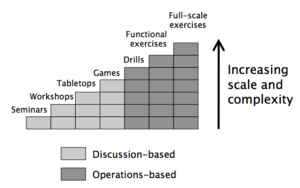Every organization needs a Crisis Action Plan. What to do, where to go and what happens next – regardless of the crisis, emergency or disaster which may occur. When building your Crisis Action Plan (or Emergency Action Plan), we recommend it be made as part of an overall set of emergency plans, which also include Crisis Communications and Continuity of Operations Plans.
Planning
We also recommend following a construct called POETE – Planning, Organizing, Equipping, Training and Exercising. First you need to get the buy-in of your leadership team to build and adopt/adhere to a Crisis Action Plan. This will undoubtedly involve Human Resources, Legal and other compliance oversight and approval. There are also U.S. Federal Occupational Safety Health Administration (OSHA) requirements and federal laws related to workplace safety, which most organizations must adhere to – and they include the need for a written Crisis Action Plan (aka Emergency Action Plan) for organizations with 10 or more employees.
We have a free checklist of what needs to comes next. And if you want, you can use our Crisis Action Plan template for free, too. We offer this extensive plan template at no cost on purpose – we really want every organization to have a Crisis Action Plan for their staff and visitors to their site(s). Get our Crisis Action Plan Template by clicking on the “Free Download” button below:
You can also find a free sample of a quick, concise two-page emergency action plan summary, from the U.S. state of Wisconsin’s capital complex here.
Organizing
- Your organization will need to build (and train) a Crisis Communications Team
- Same for an Emergency Response Team
- You will need to identify who is the main Point of Contact (POC) for your Information Technology Team
- And the same for any facilities/logistics teams – even if it is outside vendor (building maintenance, contractor)
- Alert System Name, if your organization uses one – and who activates/uses it.
Our Crisis Action Plan template above, covers all these teams and organizational constructs.
Equipping
The general workforce needs no equipment to participate in Crisis Action Plans, but they do need to know where to go (for example if evacuating to an emergency assembly area or sheltering-in-place in a safer room); and there is some training associated with tools which may be needed for a Lockdown. Emergency Action and Crisis Communications Teams both have equipment needs, and those will be identified in their own respective plan documents.
Training
We can build custom videos for you to introduce Crisis Action Plan training elements to your organization. Here’s a sample:
Once the Crisis Action Plan is approved and distributed, we recommend a stair-stepped approach to training both the general workforce members and the members of the Emergency Response and Crisis Communications Teams (as well as any other specialized teams established in your organization).
- Start with an online pre-recorded introduction seminar. One they can view at their own pace and time schedule. If you have a learning management system which can document that they have completed viewing of this video, add it to that system, as you would ethics and computer safety training.
- Your Emergency Action Team and Crisis Communications Team will need workshops for what they need to do, and then
- Everyone can (and should) participate in Drills and Exercises.
- Evaluate the training through exercises and other feedback methods (post-course evaluations, etc.) and revise the whole POETE process, as needed.
Exercising

We mentioned two of the discussion-based exercises above (seminars and workshops). There are also tabletop exercises which can be done and then games (such as online quick microsimulations), drills and functional & full-scale exercises. Each of these types of exercises should be built upon the lower level first. We do not recommend jumping into a full-scale exercise with other groups, such as first responders, on any subject/hazard, until you and your own teams have practiced that same subject/hazard on your own via this stair-stepped approach. You should also evaluate the results of all exercises to see where the plans, organization, equipment and training needs to be revised and/or redone. Practice makes perfect, as they say. Barton Dunant has a ton of exercises for your team. Take a look at our catalog or let us know directly if you would like us to build or remotely facilitate an exercise for your organization.